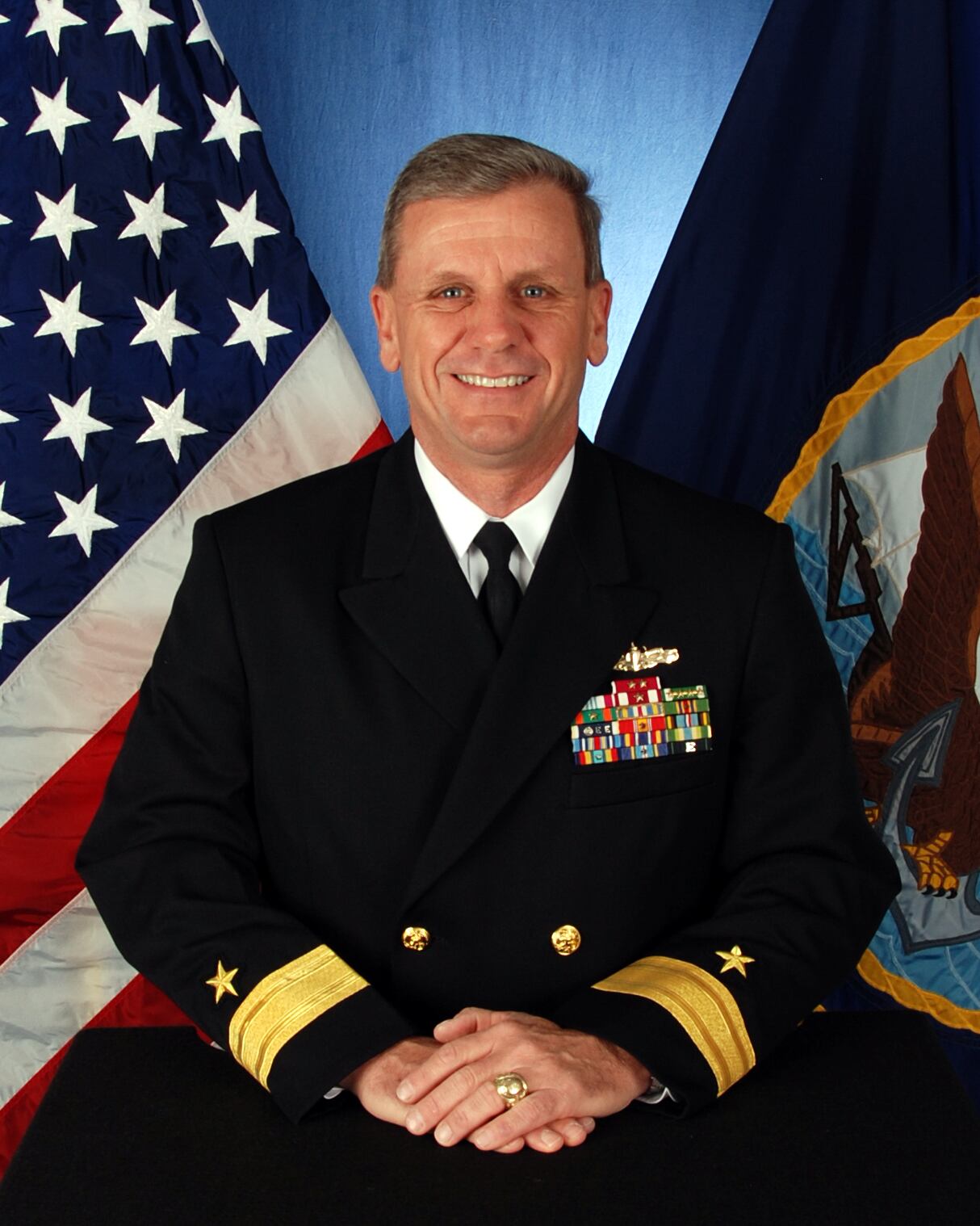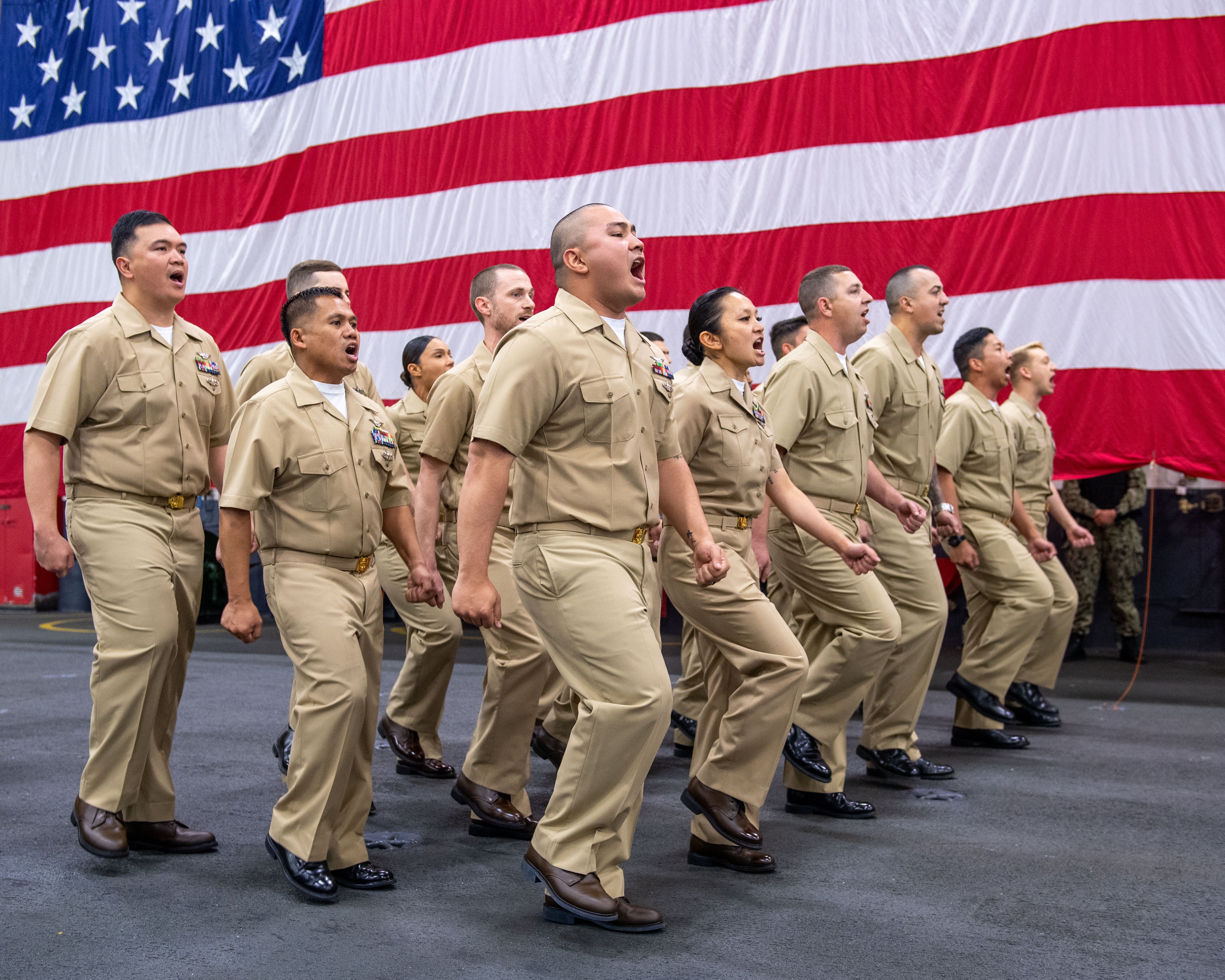Rear Adm. Rich Brown has had his work cut out for him. In his year as the Navy's accessions czar, he contended with a widespread fitness cheating scandal at boot camp and oversaw a test of the first — and by all accounts, overdue — issuance of tablet computers for recruits. been in command of Naval Service Training Command, he's navigated a recruit physical training cheating scandal and has overseen the first tests of tablet computers being issued to recruits.
As head of Naval Service Training CommandNSTC, he's supervised overseen all new accession training into the Navy, both officer and enlisted, except for at the Naval Academy, which answers directly to the Navy's señor leadership.
On the officer side, he's led overseen a review of officer accession training from the bottom up, and has begun begun a reforming in how Naval Reserve Officer Training Corps scholarships are managed.
"I'm probably a bit biased, but I think this is the best one-star billet out there," said Brown. "The impact the NSTC commander can have on the future force is incredible, and I don't think there's any higher calling than the care and feeding and training of these young men and woman as they transition from civilian into Navy — we've got to get it right."
Brown is leaving Great Lakes, Illinois, next month to lead the head to Carrier Strike Group 11 — the carrier Nimitz Carrier Strike Group, in Everett, Washington.
Though he's excited to get back to sea, the former destroyer and cruiser skipper, said he's had a great introduction to the flag rank at Great Lakes. He talked to Navy Times about his busy year at NSTC. commander of both a destroyer and a cruiser says his job at NSTC has been a great into into the flag rank — and a busy year.
Brown sat down with Navy Times in a June 23 phone interview to discuss his year as the Navy's accessions czar.
Sailor tablets
When Brown took over at NSTC last June, the command was already in the early stages of preparing to hand out tablet computers to recruits during training. of working with Master Chief Petty Officer of the Navy (AW/NAC) to kick off the eSailor pilot program of issuing tablet computers to recruits to use during training.
On April 8, Brown helped Master Chief Petty Officer of the Navy (AW/NAC) Mike Stevens hand out the tablets to the first group of 200 recruits and said during that event, he felt a bit like he was witnessing history.
"It was the one of those feelings where I felt I might look back at this event and be able to sday, 'I was there at the start,'" he said in the June 23 phone interview.
The Navy is on the right track by issuing tablets or enabling sailors to use their own, he said. Above all, he's come away with the idea that the Navy is on the right track with either issuing or enabling sailors to use tablets and smart devices as part of their jobs — and something he's seen a lot of support from the Navy's leadership.
"When it comes to big Navy, I have seen little resistance to the concept of the e-sailor concept," he said. "Usually when you are trying to do something incredibly different at someplace like RTC, the nay sayers are going to come out of the woodwork question the changes."
But, Brown says, going down the e-sailor path is the right thing to do for the Navy
"These young men and women are growing up with this kind of technology," he said. "And this generation is kind of a transition generation, because tablets started becoming popular about doing their lives."
Many of the recruits, he said, have already used tablets in school and say that e-learning is critical, said Brown, who points out that he's used Internet videos to help him fix his car. Similarly, the recruits' tablets were loaded with instructional videos.

Rear Adm. Richard A. Brown, head of Naval Service Training Command, says there's "no higher calling" than providing the right training and guidance for men and women entering the fleet.
Photo Credit: Navy
.and used to learning technology to learn.
And most are used to now learning this way, too, as have many others, including Brown himself, who said he has used internet video tutorials to help him fix his car.
At RTC, the recruits' tablets were loaded with videos that showed them how to do many things such as folding clothes and making their racks.
"We made videos out of many of those things — how to set up your rack, how to fold your clothes," he said. "We found the recruits were going back to that video again and again — that's how they are used to learning."
Within five years, he predicts, He says if you project that out five years or so, sailors will be using such videos for routine work like preventive maintenance. help them to preventive and emergency maintenance on the deckplates.
"Wouldn't it be great if, before you cracked the first bolt, you could watch that whole action on video? before you ever start," he said. "I just think this is the way it should be."
The first pre-pilot in April and May, he described as "rudimentary" but a necessary first step, needed to tested how recruits used them and how they stood up to a beating. s well as how the products stood up to recruit punishment.
"We had some kind of damage to 54 of the tablets, but these were off the shelf, non-ruggedized — the same kind you could buy in a store yourself," Brown said.
"We did this intentionally because we wanted see how they would perform and would they survive the training environment and the answer is that some of them did."
The next pilot will happen this month and they'll also introduce some of the Milspec ruggedized versions during that test, he said.
"We did extensive surveys with both the [recruit division commmander's] and the recruits asking them everything from how had they used tablets in the past to what they use them for now."
The final analysis of this survey isn't done yet, but the initial feedback he's getting has been "very positive from both the RDC's and the recruits."
After the second July test, they'll analyze again, decide which tablet they'll use and go with a full-blown pilot test possibly in the fall or after the beginning of the new fiscal year.
That test is expected to involve a whole "ship," as the barracks at boot camp are called. It will be outfitted with Wi-Fi and hundreds of recruits and staff will participate.
Only then, Brown said, can the Navy determine if it's feasible to start issuing tablets to recruits, which will follow them through their careers. to expand even more with the goal of eventually having tablets that can be issued to sailors at boot camp that will go with them to A and C schools and on into the fleet.
"It's quite a learning curve and we're trying everything, just to learn. This is how deep we're doing this," he said "We don't want this to fail from a logistics standpoint when the idea itself is very sound."
PT cheating
Brown says Recruit Training Command is moving on from its review of widespread cheating earlier this year.
The probe began when Late last year an investigation at Recruit training command was triggered when two sailors reporting to the Nuclear Power Training Command in Charleston, South Carolina, failed their initial fitness test conducted during their command check in after they were caught cheating by inflating each other's pushups and sit-up counts.
When the string was pulled, They, in turn, blamed sailors fingered recruit division commanders at Great Lakes for as encouraging them to cheat on that portion of the test to ensure that no one failed.
The month-long investigation concluded that "cheating by recruits on the final PRT is a common practice that is contrary to the Navy-wide standard for administering a PRT and the RTC maxim," the investigating officer concluded. , whose name was redacted from the released report, wrote in the report.
The report identified 59 RDCs, varying in rank from second class to chief, for disciplinary action. Of those, 20 RDCs ended up being implicated for telling or implying to their recruits that they should cheat on the final fitness tests; they were recommended for disciplinary or administrative action. The remaining 39 were cleared.
Though Two were disciplined at mast, but most of the others were only ordered to retrain as RDCs. , were told by Capt.W. Douglas Pfeifle, RTC's CO, that that they'd have to retrain as RDC's before they'd be allowed to continue training recruits.
"We had 18 RDC's that we put back in training. They've all completed training and are pushing boots again," Brown said. I just talked to Capt. [W. Douglas] Pfeifle about that a couple weeks ago and his sense is that we had to take a look at what our standards were and how do we uphold them and communicate that to the whole command."
Brown backed Pfeifle's decision to retrain most instead of disciplining them.. And says as a result, the command is well on the way to putting the scandal behind them and ?moving forward.
"I don't believe there was a widespread abandonment of standards because we have 600 RDCs and there were only 20 that were questionable," Brown said. "Of those, there were only two who might have really crossed the line."
But he said discipline and standards are critical at a command with the importance and visibility of RTC discipline was carried out was important.
"Something like this could really could tear a command apart, and that did not happen," Brown said. Capt Pfeifle did a great job of communicating to the 98 percent of the RDC's what had happened and reiterating what the standards were."
He believes that duty pushing boots at Great Lakes is a tough job and is essentially sea duty on shore.
"We bring these sailors from the fleet and they work hard during their tours here," Brown said. "And then we send them right back to sea — that's tough."
He's hopeful, however, that more rewards for duty at Great Lakes and feels when the new Meritorious Advancement Program is extended to some shore commands, that Recruit Training Command should be near the top of the list.
"Every RDC that comes here are all very competitive and have EP's on their evals from the fleet. But they come here and have to compete with folks just like them and not everybody can be an EP — there has to be some avenue to ensure their advancement rate exceeds that of the fleet."
Officer accession trainingTraining
Brown said one of the first things on his plate when he took over a year ago was a deep, three phase review in officer accession training.
At the heart of the review is a look at all the "core competencies" of what the Navy wanted in an officer today, with an eye toward teaching the same things at ROTC and Officer Candidate School. what they were teaching at in ROTC, at officer candidate school were still the same. Even the Naval Academy has participated in the review, which is still ongoing.
All entry level officer performance requirements and the training needed to teach them, are being reassessed in reviewed.
Brown said that a panel of mostly O-6's and a few O-5's will brief the officer accession training executive steering committee in late July.
"They're going to formulate the recommendations for any additions, changes and deletions to the training," Brown said. "This will be a pretty far ranging review of officer core competencies." — I'll be leaving that to my relief and he'll be able to do that right out of the blocks."
Brown also has overseen a change in how the Navy handles attrition in the Naval Reserve Officer Training Corps scholarship program. In previous years, the Navy would over-enroll college students in ROTC, with the calculation that a percentage would drop out. Now, the Navy offers only as many scholarships as there are quotas and will only shift the quotas to other qualified candidates when a midshipmen receiving a scholarship drops out.
"In the past, if we projected needing 750 ensigns in a graduating class four years later, we would overload the freshmen class and put 950 four year scholarships into the program," Brown said. "That would account for the attrition over the four years."
But that practice is now changing, he said.
"What we're going to do is what I call "precision load" the freshman class," he said.
For example, he said, if the Navy needs the class to graduate 750 ensigns, then the Navy will only plan for 750 scholarships in the program for those four years, he said.
Now, when midshipmen drop out of attrited from the ROTC scholarship program, the rest of that scholarship's funds won't go away, the Navy will find someone else to give them to.
Where they'll find these new scholarship recipients, Brown said, will be from the ranks of those non-scholarship midshipmen who are participating voluntarily, and footing their own college bill.
"We have what we call the "college program", where folks can join the NROTC program," Brown said "Unlike the scholarship midshipmen, these midshipmen don't get any tuition or stipend and for those."
But now as scholarship mid's drop out, their scholarships will be doled out in two and three-year scholarships to deserving volunteer midshipmen.
"There is a tremendous amount of talent in the college program and now these midshipmen, if they're top performers in their studies and leaders in their battalion, are going to have a much greater opportunity to get a scholarship and we're pretty excited about it."
Mark D. Faram is a former reporter for Navy Times. He was a senior writer covering personnel, cultural and historical issues. A nine-year active duty Navy veteran, Faram served from 1978 to 1987 as a Navy Diver and photographer.




